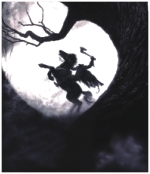|
Classic Corner
The legends of Sleepy Hollow
Washington Irving
Washington Irving was born in New York City (near present-day Wall Street) at the end of the Revolutionary War ( April 3, 1783November 28, 1859). He is perhaps best known for his short stories, his most famous being “The Legends of Sleepy Hollow and “Rip van Winkle”, but he was a prolific writer of essays, biographies, and other forms as well. Irving is said to have mentored authors such as Nathaniel Hawthorne, Henry Longfellow, and Edgar Allan Poe. Irving was a lawyer, and a member of the American diplomatic staff in Britian and in Spain. He was a prolific essayist who wrote widely respected biographies of George Washington and others, and wrote a number of books on 15th century Spain dealing with subjects such as Columbus, the Moors and the Alhambra.

Story in brief
The dominant spirit, however, that haunts this enchanted region, and seems to be commander-in-chief of all the powers of the air, is the apparition of a figure on horseback, without a head. It is said by some to be the ghost of a Hessian trooper, whose head had been carried away by a cannon-ball, in some nameless battle during the Revolutionary War, and who is ever and anon seen by the country folk hurrying along in the gloom of night, as if on the wings of the wind. His haunts are not confined to the valley, but extend at times to the adjacent roads, and especially to the vicinity of a church at no great distance. Indeed, certain of the most authentic historians of those parts, who have been careful in collecting and collating the floating facts concerning this spectre, allege that the body of the trooper having been buried in the churchyard, the ghost rides forth to the scene of battle in nightly quest of his head, and that the rushing speed with which he sometimes passes along the Hollow, like a midnight blast, is owing to his being belated, and in a hurry to get back to the churchyard before daybreak.
Such is the general purport of this legendary superstition, which has furnished materials for many a wild story in that region of shadows; and the spectre is known at all the country firesides, by the name of the Headless Horseman of Sleepy Hollow. many a wild story in that region of shadows; and the spectre is known at all the country firesides, by the name of the Headless Horseman of Sleepy Hollow.
It is remarkable that the visionary propensity I have mentioned is not confined to the native inhabitants of the valley, but is unconsciously imbibed by every one who resides there for a time. However wide awake they may have been before they entered that sleepy region, they are sure, in a little time, to inhale the witching influence of the air, and begin to grow imaginative, to dream dreams, and see apparitions.
They are like those little nooks of still water, which border a rapid stream, where we may see the straw and bubble riding quietly at anchor, or slowly revolving in their mimic harbor, undisturbed by the rush of the passing current. Though many years have elapsed since I trod the drowsy shades of Sleepy Hollow, yet I question whether I should not still find the same trees and the same families vegetating in its sheltered bosom.
Copyright
(R) thedailystar.net 2006 |
